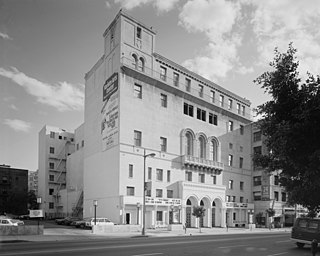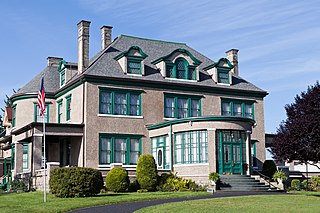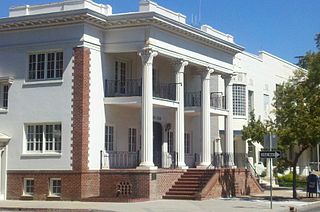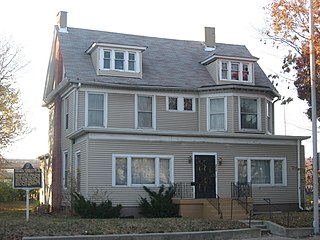
The University Cottage Club or simply Cottage Club is one of eleven current eating clubs at Princeton University, in Princeton, New Jersey, United States. It is one of the six bicker clubs, along with The Ivy Club, Tiger Inn, Cap and Gown Club, Cannon Club and Tower Club.

El Centro Español de Tampa is a historic building in the Ybor City neighborhood of Tampa, in the U.S. state of Florida. Built as an ethnic and cultural clubhouse in 1912, the red brick structure situated at 1526–1536 East 7th Avenue is today part of a shopping and entertainment complex. It remains one of the few surviving structures specific to Spanish immigration to the United States during the late 19th and early 20th centuries, a legacy which garnered the Centro Español building recognition as a U.S. National Historic Landmark (NHL) on June 3, 1988. El Centro Español de Tampa is one of two individual structures within Hillsborough County to be so designated.

The Woman's Club of Palmetto is a women's club and is also the name of its historic building in Palmetto, Florida. It is located at 910 Sixth Street West. The building was added to the National Register of Historic Places in March 1986.

The Lemon Bay Woman's Club is a historic woman's club in Englewood, Florida, United States. It is located at 51 North Maple Street. On August 11, 1988, it was added to the U.S. National Register of Historic Places.
The Lemon Bay Woman's club was organized by Dr. Mary Green who was a school teacher in Englewood. Originally named the Lemon Bay Mother's Club, a name retained until April 1924, the club played an important role in the development of the religious, educational, civic and political life of Englewood. Construction on the prairie style clubhouse was begun in September 1925 on two lots donated in Lampp subdivision by A. Stanley and Winifred E. Lampp. Englewood, incorporated in 1925, and the surrounding area then boasted 300 residents.
Sarasota architects Thomas Reed Martin and Clare C, Hosmer, formerly of Chicago, donated their design services for the building. Carpenters Pat Lampp, Fred Clark, and Leroy Bastedo were responsible for the clubhouse construction. The building originally consisted of a screened veranda and one large meeting room featuring a brick fireplace and a semi-circular stage, for which total construction cost was 3,120. A housewarming held on February 19, 1926, attracted 200 persons. Official incorporation, a year later, occurred under the direction of Charlotte Wellington, president.
In 1922, under the leadership of Mrs. Hallie Green, members started a school library and maintained a lending library at the club until 1962. Surviving the depression and the loss of its $37 treasury when banks failed, the club continued to hold fish fries, nature study classes, dances, card parties, plays, musical programs, travelogues and lectures. The club retired its mortgage on February 24, 1938. The note was burned at a gala meeting on March 4, 1938
Between 1926 and 1970, the club served as a sanctuary for many Englewood churches and as a meeting place for various organizations. The Englewood Community Church was the first congregation to meet at the club. Others included the Community Presbyterian Church, First Baptist Church, St. Raphael's Catholic Church, St. David's Episcopal Church, Evangelical Free Church, Church of God, Church of Christ, First Methodist Church, and Calvary Baptist Church. During World War II the building was turned over to the American Red Cross. The club was the first building in Englewood to be listed in the National Register of Historic Places.
Montgomery House may refer to:

The Friday Morning Club building is located in Downtown Los Angeles, California. It was the second home of the women's club also named the Friday Morning Club (FMC), for 61 years.

Thomas W. Fleming House, also known as the Clubhouse of the Women's Club of Fairmont, is a historic home located at Fairmont, Marion County, West Virginia. It was built in 1901, and is a 2+1⁄2-story, U-shaped, stucco masonry building in a Colonial Revival / Beaux-Arts style. It has a rectangular central block that is joined at the rear by two short wings. It features rounded, glass-enclosed entrance solarium. It became the clubhouse of the Fairmont Woman's Club in 1938. Its builder, Thomas W. Fleming (1846-1937), served two terms as mayor of Fairmont and was elected to the House of Delegates in 1905.

The Stotesbury Club House is a historic, American clubhouse that is located in Wyndmoor in Springfield Township, Montgomery County, Pennsylvania.

The Cottonwood County Courthouse is the seat of government for Cottonwood County, Minnesota, United States, located in the city of Windom. It has been in continual use since its dedication in 1905. It was listed on the National Register of Historic Places in 1977 for its state-level significance in the themes of architecture and art. It was nominated for the neoclassicism expressed throughout the building, from the exterior architecture to the interior design and artwork.

The Woman's Club of Lodi is a historic building located at 325 W. Pine St. in Lodi, California. The building was constructed in 1923 to house the city's Woman's Club, which was formed in 1906 as a civic improvement group. The building housed performances and social events in Lodi; as the largest civic auditorium in the city, it served as the only building which could host social functions during the 1920s. Community events continue to be held in the building through the present day.

The Silver City Woman's Club is a historic women's club located at 411 Silver Heights Boulevard in Silver City, New Mexico. The club was founded in 1909, and it built its meeting house in 1935–36. Richard Tatsch designed the clubhouse in the Pueblo Revival style, which reflected the region's architectural history. The clubhouse provided two spaces for the club's community activities and private meetings; the former included distributing food to needy families and conducting child welfare inspections on behalf of the state, while the latter included self-improvement courses in music and literature. The women's club has continuously held its activities in the building since its construction; it has also provided a space for community meetings and large events.

The Woman's Club of El Paso was founded in the late nineteenth century, and during that time was the only woman's organization in El Paso, Texas. The Woman's Club also allowed women in El Paso to become involved in community service and activism. The building which is the home for the club is located on 1400 N. Mesa Drive, and was erected in 1916. The club, now a non-profit organization, traces its official origins back to 1894, and continues to provide an "educational and cultural center for its members." The building is registered in the National Register of Historic Places.

Indiana State Federation of Colored Women's Clubs, also known as the Minor House, is a historic National Association of Colored Women's Clubs clubhouse in Indianapolis, Indiana. The two-and-one-half-story "T"-plan building was originally constructed in 1897 as a private dwelling for John and Sarah Minor; however, since 1927 it has served as the headquarters of the Indiana State Federation of Colored Women's Clubs, a nonprofit group of African American women. The Indiana federation was formally organized on April 27, 1904, in Indianapolis and incorporated in 1927. The group's Colonial Revival style frame building sits on a brick foundation and has a gable roof with hipped dormers. It was listed on the National Register of Historic Places in 1987.

The Midwest Oil Company Hotel, at 136 East 6th Street in Casper, Wyoming, is an historic hotel building which was listed on the National Register of Historic Places in 1983. It has also served as the Casper Women's Club House. Originally built by the Midwest Oil Company to accommodate workers during the Casper oil boom, it was taken over by Standard Oil Company of Indiana when that company bought Midwest Oil. In the 1930s, in the waning days of oil production in Natrona County, a local women's organization bought the hotel for $8,000 and was renamed the Casper Women's Club House.

The Dawson Woman's Club was founded in 1905 as the "Wednesday Afternoon Club" and became a member of the Georgia Federation of Women's Clubs in 1907.

The Tennille Woman's Clubhouse, at 132 Smith St. in Tennille, Georgia, was built in 1922. It was listed on the National Register of Historic Places in 1998.

The Glendale Woman's Club was first organized in 1901 as a “Self Culture Club”, the primary aim of the Woman’s Club was self-improvement from a literary standpoint. They raised money for the first library and city parks. In 1898 the lumber company moved to a new two-story office building; Mr. Messenger could no longer manage the library. A library association was formed. The women’s club bought up stock and then assigned members to vote. Mrs. May Catlin Hanson, through club member Mrs. Lafe Myers, donated a building which was placed in park to house the library until a new one could be built. Mrs. Robert Clark and Mrs. J.M. (Mary) Pearson took the lead. Mary took a class on “Library work” in Phoenix to be able to “start it out right.”. By 1907, membership had increased to fifty members and it became impossible to continue meeting in homes, so the group began to think of acquiring its own clubhouse. On February 21, 1912, exactly 1 week after Arizona became the 48th state, the Club was recognized 501c3 non profit corporation with 85 members. The Glendale Woman's Club is a member of the General Federation of Women's Clubs.

The Woman's Improvement Club Clubhouse in Corona, California, at 1101 S. Main St., was built in 1913. It was listed on the National Register of Historic Places in 1988.



















